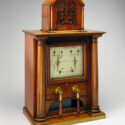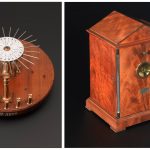A tale of two telegraphs: Cooke and Wheatstone’s differing visions of electric telegraphy
Article DOI: https://dx.doi.org/10.15180/170804
Abstract
This paper explores the early development of practical electric telegraphy in Britain during the nineteenth century. It exposes the two fundamentally different approaches to the design of telegraphic instruments specified in a joint patent between William Fothergill Cooke and Charles Wheatstone in 1840. Cooke’s design was a relatively simple needle instrument that required skilled operators to transcode and transcribe the telegraphic despatches. Wheatstone’s design, on the other hand, relied on an innovative step-by-step (escapement) technology which was at the heart of a user-friendly, albeit more complex dial instrument that could be operated by any literate person. The deteriorating relationship between the two men during this period had a detrimental impact on the development of telegraphy. To prevent Wheatstone benefiting from the commercial venture that came to be known as the Electric Telegraph Company, which Cooke believed should be entirely his own, in 1845 Cooke acquired the full rights to the joint patent and subsequently ignored Wheatstone’s design, stifling in the process the development of the promising step-by-step technology. It would be another twelve years before Wheatstone resumed work on this technology and produced ultimately the ABC instrument – a dial telegraph that marked a milestone in the history of communication.
Keywords
ABC instrument, alphabetic instrument, Cooke, dial instrument, Electric telegraph, escapement telegraph, hatchment dial, needle instrument, universal instrument, Wheatstone
Introduction
https://dx.doi.org/10.15180/A dial instrument – a telegraph, that is, provided with alphabets engraved on a circular dial, and an index made to revolve and point to any required letter is more simple. Several such telegraphs exist, and among them are some very happily arranged; and there is something so simple in the fact of being able to point to any desired letter, that it is no wonder the public generally may, on a hasty glance, and before studying the practical merits of the case, be ready to decide in their favour, and prefer them to any other plan, the A, B, C of which is less obvious.[1]
A keen observer of Victorian society, and ever interested in new developments in science, Charles Dickens often published non-fiction articles. This time, as illustrated in the epigraph, Dickens had chosen the topic of the electric telegraph. Here, he provides a glimpse into dial instruments and hints at their simplicity of operation and suitability for the public, although they had yet to be commercialised.
In 1850, the year in which Dickens wrote this article, the mainstream telegraphs were the one- or two-needle instruments operated by the skilled operators of the Electric Telegraph Company. None of the dial instruments, invented by Charles Wheatstone a decade earlier, were in general use. I explain below how the fraught relationship between William Fothergill Cooke and Charles Wheatstone stifled the development of the dial instrument in Britain. The received view from Jeffrey Kieve’s seminal work on the history of the electric telegraph draws attention to the commercial and emotional factors that fuelled the conflict between these two men in the early 1840s (Kieve, 1973), pp 40–43).[2] However, Kieve’s work does not cover the impact this conflict had on the development of the electric telegraph. As this paper reveals, the conflict had also a technological dimension. Cooke and Wheatstone had indeed two fundamentally different views on the design of telegraphic instruments, but this multi-directional approach to the development of telegraphy was temporarily disrupted by this conflict.
A fragile partnership
https://dx.doi.org/10.15180/170804/002The partnership between Cooke and Wheatstone was a key determinant in the early development of the electric telegraph in Britain. Yet this partnership lasted for a relatively short period of time, from 1837 to 1840. In 1840, the year of their latest joint patent, a bitter dispute erupted between the two men. The dispute was as much about intellectual property rights as reputation and social standing. Despite an attempt to resolve the issue through arbitration in 1841, the conflict persisted and soured their relationship, even though they remained in contact out of business necessity, if not friendship, until Wheatstone’s death in 1875. On the face of it, Cooke came out of the arbitration proceedings in a strong position, but it would be an over-simplification to assume Wheatstone was defeated, because he subsequently managed to secure a significant financial reward in return for relinquishing his rights to their joint patent of 1840.[3] This latest agreement, in 1845, allowed Cooke to create the Electric Telegraph Company with the support of two entrepreneurs, John Lewis Ricardo, MP for Stoke and nephew of the economist David Ricardo, and George Parker Bidder, a prominent railway engineer and an associate of Robert Stephenson, the son of George Stephenson who had built the Stockton & Darlington Railway.[4]
From the start of their relationship, Cooke and Wheatstone had demonstrated two very different yet complementary approaches to telegraphy. Initially, Cooke envisioned the telegraph to be a signalling device to improve the safety of train operation – a business opportunity in the fast-growing railway industry.[5] The needle instrument was well adapted for this purpose as it was cheaper to manufacture and easy to operate as a signalling device. As far as Cooke was concerned, there was no need for the sophistication of the dial instrument. Wheatstone, on the other hand, saw in electric telegraphy a means of interpersonal communication – a vision which assumed that the instruments were domesticated and could be operated by any literate person. After gaining full control of the joint patent in 1845, Cooke ignored the dial instrument which represented Wheatstone’s vision of telegraphy and for the next twelve years, as we shall see below, the needle instrument became the mainstream technology for British telegraphy. Before exploring in more detail this conflict and its aftermath, however, a short history of the technology described in the joint patent of 1840 is needed to understand the context in which these events were taking place, starting in the early days of 1837.
The needles and the dial
https://dx.doi.org/10.15180/170804/003Three months after their first meeting, in February of 1837, Cooke and Wheatstone filed their first joint patent for a telegraph instrument (Cooke and Wheatstone, 1837). This patent describes improvements that made the instrument practical – presumably in reference to Cooke’s earlier mechanical telegraph that was never operational. One of the important contributions from Wheatstone consisted of an apparatus known as the Hatchment Dial with its characteristic diamond-shaped vertical board. This device employed magnetic needles that were set on a horizontal line in the centre of the dial. The needles pointed up at rest, or left or right when deflected by the action of an electric current. Letters were indicated by the simultaneous deflections of two needles in contrary directions. Wheatstone’s innovations were the vertical mounting of these needles, the dial’s alphabetic arrangement, and the so-called ‘permutating’ keyboard that operated the needles.
After a short practice, any literate person could operate the device proficiently as it offered direct read capability. This was not a small instrument, let alone easily transportable, but it already revealed Wheatstone’s inclination towards designing telegraphic instruments for use by the general public.

The Hatchment Dial instrument was successfully tested in 1837 during the London & Birmingham Railway experiment from Camden Town to Euston, but the cost of constructing and laying the five wires was a financial and engineering burden.[6] For the next project, which took place at the Great Western Railway Company, Cooke designed an enhanced version of his mechanical telegraph which incorporated Wheatstone’s electro-magnetic improvements: a two-needle apparatus that operated on only three wires. This instrument was an efficient signalling device in railway operation, but it did not have a direct read capability in alphabetic operation as it used coded sequences of needle deflections to communicate the messages (for instance, two deflections to the right to mean X, one to the right and one to the left to mean Y, etc.). It was to be worked by skilled operators.
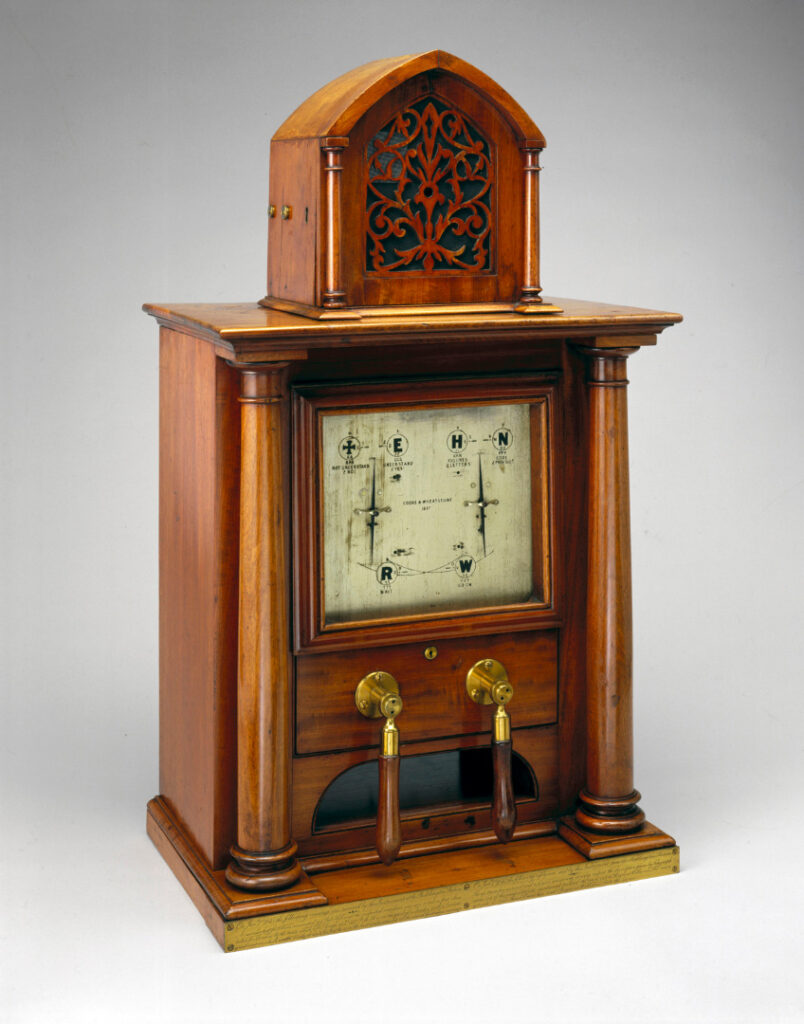
Wheatstone was also determined to reduce the number of wires, while preserving at the same time the benefit of direct read. In 1840, he designed a new instrument that was partly based on an earlier design by Francis Ronalds.[7] This instrument required two wires to operate and it was built around three components: a transmitter, a receiver, and an alarm. The receiver was designed around a clockwork mechanism. It employed a step-by-step rotating circular dial that moved one step at a time, in one direction, with each electrical impulse received from the remote transmitter. The dial was divided into twenty-four sectors identified by letters, numbers and special characters, and these symbols were presented in a small aperture on the front of the instrument. The transmitter worked by positioning a finger at the edge of a capstan on a space associated with the letter or number to be sent, and rotating the capstan until it reached an index (see Figure 3). This action caused the mechanism behind it to make and break the circuit, sending an electrical impulse as each preceding character passed in front of the index. This was, in effect, an early version of the rotary dial used on future telephones. This instrument was called the escapement or the dial telegraph. Unlike the Hatchment Dial, it was small enough to be carried in a small case and was capable of operating at about thirty characters per minute.
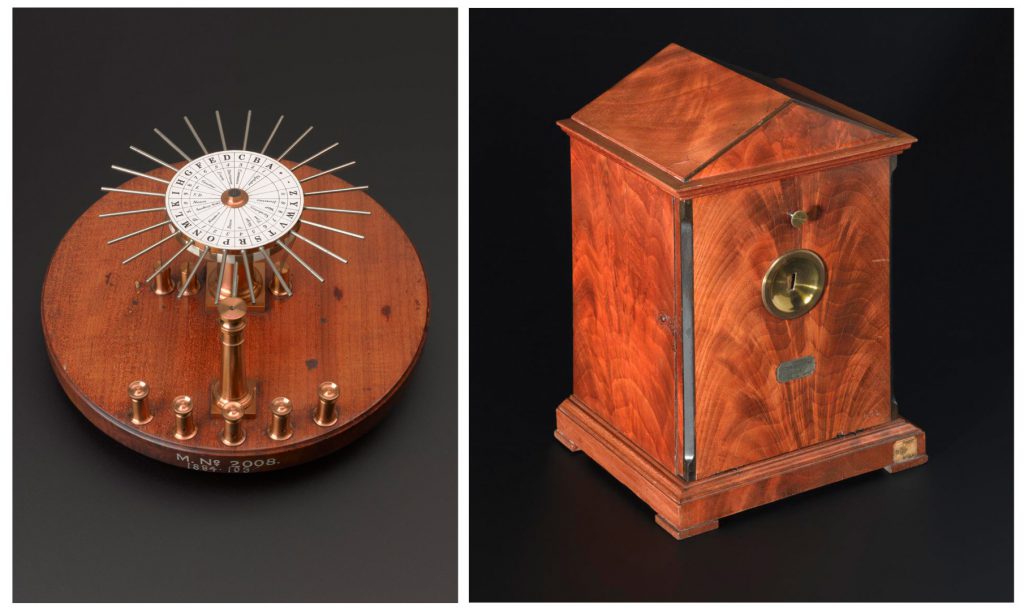
The step-by-step technology featured prominently in the joint patent filed in 1840 (Wheatstone and Cooke, 1840).[8] The patent also included improvements made by both Wheatstone and Cooke for the needle instrument that we saw earlier – the one used for the Great Western Railway project.
A bittersweet victory
https://dx.doi.org/10.15180/170804/004Just as this project was beginning to bear fruit, however, Cooke saw the press deny him recognition for his role in the invention of the electric telegraph. On 16 October 1840, for instance, the following article was published in The Times:
Professor Wheatstone, the inventor of the electrical telegraph which is now at work on the Great Western Railway, is at present in Brussels, where he has been trying the new improvements he has introduced in his apparatus. Mr Wheatstone has succeeded in so simplifying his apparatus that he has reduced the number of wires employed to two.
On first reading of the initial sentence, the reader might be forgiven for inferring that Wheatstone should be solely credited for inventing the electric telegraph. On closer inspection, however, it is clear that the second sentence referred to Wheatstone’s escapement or dial telegraph, not Cooke’s needle telegraph. Perhaps the difference between the two instruments had eluded the writer of this article. Perhaps also, the writer chose to emphasise the role of Wheatstone who, as professor of experimental philosophy at King’s College and a Fellow of the Royal Society, made the story more credible or more appealing to readers. Nonetheless, similar misrepresentations had occurred before. A few months earlier, for example, Wheatstone had been questioned on the subject of telegraphy during a session of the Select Committee on Railway Communication. The report shows that although Cooke’s contribution was acknowledged to a lesser degree, it was Wheatstone and ‘his inventions’ that took centre stage in the committee’s report. According to Cooke, but also reported in the Morning Chronicle dated 9 July 1840, he was waiting at the door of the committee room but was never called in for questioning (Cooke, 1857, p 37). Wheatstone’s public statements, Cooke believed, were delivered in a disingenuous manner by intentionally omitting his contribution to the electric telegraph. To the judgemental Cooke, this was unacceptable.
Wheatstone was correct in describing this escapement or dial ‘apparatus’ as his own, but Cooke took the position that his own mechanical instrument was at the origin of Wheatstone’s device – even though the two technologies were fundamentally different. Wheatstone rejected these accusations in a letter to Cooke – a letter in which, in a rare display of bitterness on his part, he reminded Cooke that, first, he never had the intention to ‘give up his right to call his own discoveries and inventions his own’, and, second, that Cooke’s instruments were tentative prototypes, while his instruments had demonstrated their practicality from the very beginning (Wheatstone, 1855, p 65). Indeed, Cooke was a businessman and an inventor, but he had little understanding of Ohm’s Law and of the significance of electrical resistance in metallic wires.[9] In contrast, Wheatstone was a man of science, well-versed in matters of electricity.[10] Cooke had also perhaps forgotten that his own mechanical arrangements were never practical, and might never have been operational without the scientific insight of Wheatstone, as evidenced by a letter he wrote to his mother in February 1837.[11] Cooke’s accusations do not appear to have been financially motivated. Both men had, after all, agreed to a joint patent. However unfounded they may have been, such allegations are likely to have had another motivation: inventors in Victorian days were as much concerned about reputation and social standing, as with intellectual property ownership. As Stathis Arapostathis and Graeme Gooday wrote, contestation of ownership of an invention in the nineteenth century was not limited to law courts, but was also covered in the public press to ensure a wider recognition (Arapostathis and Gooday, 2013, p 207).[12] Such inventors, said Ben Marsden and Crosbie Smith, were also ‘adept at fashioning an image of themselves’ (Marsden and Smith, 2007, p 242). This may also have been the case here, which would explain why Cooke was intent on pursuing this matter through arbitration.
To resolve the impasse, the two parties agreed to defer to an arbitration panel. The arbitrator chosen by Cooke was Marc Isambard Brunel, the French-born engineer builder of the Thames Tunnel and father of Isambard Kingdom Brunel FRS, perhaps best known as chief engineer for the Great Western Railway. Wheatstone, for his part, nominated Professor Daniell, a colleague from King’s College perhaps best known for his invention of an efficient battery after his name, the Daniell Cell. It took five months for the arbitrators to come up with a mutual agreement on the matter, and on 27 April 1841, Brunel and Daniell made their award.
Whilst Mr. Cooke is entitled to stand alone, as the gentleman to whom this country is indebted for having practically introduced and carried out the Electric Telegraph as a useful undertaking, promising to be a work of national importance; and Professor Wheatstone is acknowledged as the scientific man, whose profound and successful researches had already prepared the public to receive it as a project capable of practical application; it is to the united labours of two gentlemen so well qualified for mutual assistance, that we must attribute the rapid progress which this important invention has made during the five years since they have been associated.
(Cooke, 1857), p 16
Initially, Wheatstone accepted the wording of this statement, giving Cooke priority over the invention, at least on the face of it. Was Wheatstone satisfied for being given the role of the scientist behind the endeavour? Brian Bowers, who produced a biography of Wheatstone, wrote that Wheatstone’s consent can be explained by his wish to ‘continue his researches in peace’ (Bowers, 2001, p 147). However, what happened next makes it more likely that the wording did not reflect the spirit of the agreement and was subject to interpretation. When Cooke’s solicitor wrote a letter asserting that on the basis of this award, ‘Mr. Cooke was in the right, and Mr. Wheatstone in the wrong’, Wheatstone immediately asked Daniell for clarification (Wheatstone, 1855, p 31). Daniell’s response on 24 May 1843 is extraordinary as it implies that Wheatstone had not been deeply implicated in the arbitration proceedings and had relied on his colleague and friend to defend his interests. Daniell responded that, due to time and budgetary considerations, the arbitration did not result in an award but in a ‘statement of fact’.[13] He also confirmed that this was not a statement about the originality of the inventions on either side, but about the commercial positioning of the parties, for Wheatstone had agreed that Cooke was ‘entitled to stand alone, with the assent of the arbitrators, for conceiving, and energetically following up his conception, that the electric telegraph might be made a profitable commercial enterprise, and for his having carried out an undertaking of such great importance to the public’ (Wheatstone, 1855, p 30). Thus, as a result of the lack of clarity of the arbitration’s result, the ‘statement of fact’ could be interpreted in different ways.
Fortunately for Wheatstone, the two parties had also concluded a separate agreement. This much less publicised ancillary agreement was attached to the main award and was considered by Wheatstone as the substance of the award. It specified his ‘separate privileges’, which included:
The right of putting before the public, as his own, the inventions described on the 1st, 2nd and 4th drawings of the specification of the patent of 1840.[14]
Cooke attempted to rescind such privileges, proposing that in return for a compensation of £1,000 out of future proceeds both names appeared on all the patented instruments. Wheatstone rejected this proposal at first but eventually, in 1843, he entered into a new agreement with Cooke. In this agreement, Wheatstone’s share of the joint patents was assigned to Cooke in exchange for royalty payments calculated on a pro rata of the length of telegraph lines (£20 per mile for the first ten miles, reduced progressively to £15 per mile beyond fifty miles). Wheatstone remained entitled to use existing and future patents, and was allowed to build and operate, free of royalty and for his own separate benefit the patented devices, but only on private ground and on telegraph lines not exceeding half a mile in distance (Cooke, 1857, pp 7, 42, 94).[15] Although this new agreement would have allowed him to develop further his business interest with the railway companies, Cooke was not fully satisfied because a significant share of his profits was going to Wheatstone, and perhaps more importantly, this would be a de facto acknowledgement of Wheatstone’s contribution to the design of his own needle telegraph – the one he intended to sell to the railways. As a result, in 1845 he offered a new deal to Wheatstone: Wheatstone would sell his rights to the royalties agreed in 1843 in return for a one-off payment of £30,000. This offer was accepted by Wheatstone, and Cooke finally assumed full ownership of Wheatstone’s electro-magnetic improvements for his needle telegraph.
Kieve’s narrative aptly addresses the resentment felt by Cooke during his dispute with Wheatstone, and Cooke’s desire to pursue on his own the business opportunities presented by the joint patent filed in 1840 (Kieve, 1973, pp 40–43). Nonetheless, he overlooked the impact this dispute had on the development of the telegraph technology: as a result of the 1845 agreement, Cooke was free of interference from Wheatstone, and was able to pursue the business of telegraphy through an exclusive arrangement with the Electric Telegraph Company.[16] Cooke was now the owner of both Wheatstone’s improvements to the needle instrument, as well as his dial telegraph. However, he concentrated his efforts on the needle instrument and relegated the step-by-step technology to a dusty shelf. This technology would have remained on that shelf if not for the emergence of a need for a domestic instrument some twelve years later (1857), triggered by a telegraphy project undertaken by the firm Waterlow & Sons, the London-based printers, lithographers and stationers.[17] By then the terms of the joint patent of 1840 had expired, leaving Wheatstone free to develop further the step-by-step technology. In 1858, Wheatstone filed a patent which described the first model of the ABC instrument – a much improved dial telegraph that was based on the step-by-step technology that featured in the joint patent of 1840.[18] It combined the transmitter, receiver and alarm into one case that also contained a magneto-electric generator and therefore did not need a separate battery for its operation (Wheatstone, 1858). The design of the ABC instrument was further improved two years later (Wheatstone, 1860). The model shown below was manufactured from 1863, and was in use until the 1930s.[19]
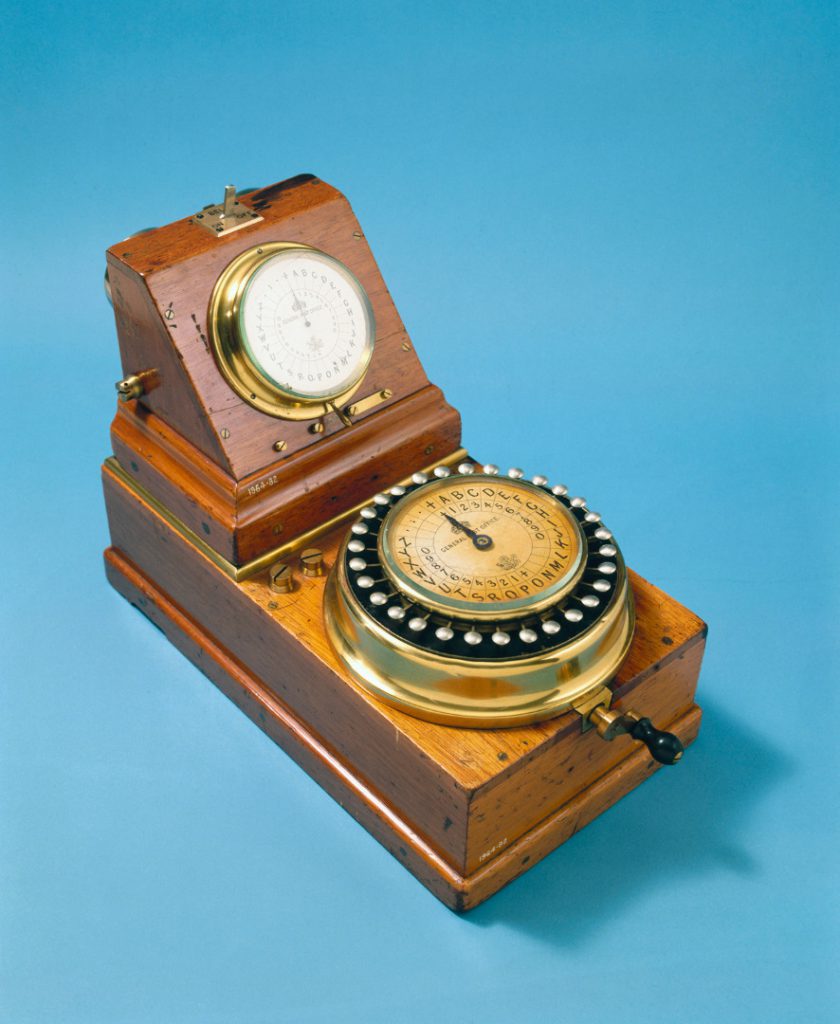
Conclusion
https://dx.doi.org/10.15180/170804/005In the early days of practical telegraphy, two visions of telegraphy co-existed. The first, championed by Cooke, was based on the relatively simple one- or two-needle instrument that required skilled operators for its operation. The second, advocated by Wheatstone, was based on the more complex but also more user-friendly dial instrument that could be operated by any literate person.
The Hatchment Dial, patented in 1837, offered direct read capability but it was a tentative device. In contrast, the dial telegraph produced by Wheatstone in 1840 was an operational instrument for use in the domestic or private sphere. However, some of its features were also incorporated in Cooke’s needle telegraph, which raised questions about ownership. Cooke’s desire to protect his standing in a society where the reputation of inventors was critical, and his reluctance to share the profits of a commercial venture which he believed should be entirely his own, resulted in years of frustrating negotiations between Cooke and Wheatstone. Eventually, in 1845 Cooke took full ownership of the joint patent of 1840, which included the dial telegraph that was based on Wheatstone’s innovative step-by-step technology. Cooke’s lack of interest in that technology, however, stopped its further development, and in effect stifled Wheatstone’s vision of a domestic telegraph. It would be another twelve years before Wheatstone resumed work on the technology and produced ultimately the ABC instrument – a dial telegraph that marked a milestone in the history of communication.
Editor’s note
This article was joint winner of the Science Museum Group Journal writing prize, 2016/17.
Acknowledgements
All photographs are reproduced with the kind permission of the Science Museum London.
Tags
Footnotes
Back to text
Back to text
Back to text
Back to text
Back to text
Back to text
Back to text
Back to text
Back to text
Back to text
Back to text
Back to text
Back to text
Back to text
Back to text
Back to text
Back to text
Back to text
Back to text




